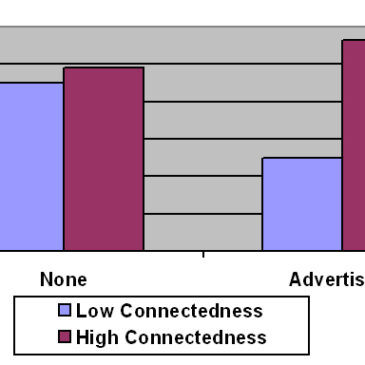Television programs frequently embed alcohol product information and alcohol-related messages within their content. This week, the DRAM reviews a paper that examines whether warnings about these embedded messages affect viewers’ responses to them (D. W. Russell & Russell, 2008).
Method
- Two hundred fifty college students viewed an episode from the popular TV sitcom, Two and a Half Men. The storyline included both positive and negative messages about alcohol (e.g., the protagonist experienced a bad hangover, but the episode suggested that his drinking allowed him to express his previously undisclosed feelings). The selected episode included several recognizable alcohol brands.
- Researchers measured participants’ level of connectedness with the show (i.e., their intensity of involvement with the episode and their identification with the characters) using a Likert-type scale (C. A. Russell, Norman, Heckler, Iacobucci, & Arnould, 2004). The researchers divided participants into high and low connectedness based on a median split.
- Participants were randomly assigned to a control or experimental condition. The experimental condition received a warning message about the episode content: “Sometimes marketers and advertisers persuade television producers to have the characters communicate specific messages about their products because, for them, it is a good way to advertise their products.” (D. W. Russell & C. A. Russell, 2008, p.462)). The control condition received no such warning.
- The researchers measured participants’ positive beliefs about alcohol consequences as one of the dependent variables.
Results
- The advertising warnings reduced positive beliefs toward alcohol, but for the low-connected viewers only (see Figure). The advertising warning actually increased positive beliefs toward alcohol for the highly connected viewers (F (2, 232) = 3.14, p < .05).

Figure. Positive beliefs about drinking for different warning conditions. Click image to enlarge.
Limitations
- Experiments conducted in lab settings benefit from experimental controls, but the artificial environment also decreases the reality of the situation for participants, potentially decreasing the generalizability of the results and the potential validity of the findings.
- The study used a convenience sample (students); this also limits the generalizability of the results.
Conclusion
The results of this study show that warnings about embedded alcohol messages can affect viewers’ beliefs about drinking. This finding is consistent with previous research that showed warnings can induce cognitive defense mechanisms and change people’s perceptions of persuasive messages (Chen, Reardon, Rea, & Moore, 1992). However, this study demonstrated that the impact of warnings vary depending upon the recipient’s “connectedness” (i.e., level of involvement) in the TV episode. Unexpectedly, though forewarning about alcohol product placement appears to reduce the effect of advertising among low-connected viewers, it might have the unintended consequence of increasing positive alcohol beliefs among high-connected viewers.
— Julia Braverman
What do you think? Please use the comment link below to provide feedback on this article.
References
Chen, H. C., Reardon, R., Rea, C., & Moore, D. J. (1992). Forewarning of content and involvement: Consequences for persuasion and resistance to persuasion. Journal of Experimental Social Psychology, 28(6), 523-541.
Russell, C. A., Norman, A. T., Heckler, S. E., Iacobucci, D., & Arnould, E. J. (2004). The consumption of television programming: Development and validation of the connectedness scale. Journal of Consumer Research, 31(1), 150-161.
Russell, D. W., & Russell, C. A. (2008). Embedded Alcohol Messages in Television Series: The Interactive Effect of Warnings and Audience Connectedness on Viewers’ Alcohol Beliefs. Journal of studies on alcohol and drugs, 69(3), 459-467.
Wood, W., & Quinn, J. M. (2003). Forewarned and forearmed? Two meta-analysis syntheses of forewarnings of influence appeals. Psychological Bulletin, 129(1), 119-138.




